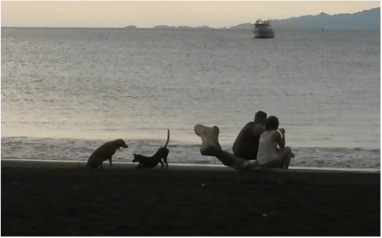A blog for all things dog-related: training, behavior, fun new doggie items, veterinary information and, of course, ways to enhance your relationship with your best four-legged friend!
|
My husband and I just returned from an amazing anniversary trip to Costa Rica. This Central American country is known for its west coast beaches, laid-back lifestyle, many volcanoes and wildlife adventures – all which we took part in happily. And in fashion to my true nature, we were in the country for less than 2 hours before I had my first interaction with dogs – Costa Rican style!
Upon driving into the town of Coco, I was pleasantly surprised to see how the dogs of Costa Rica spend their days, as it’s very different than it is here in the U.S. (Though I don’t really know why I was surprised – it’s this way in several of the other countries I have visited too). There are no leash laws in Costa Rica, so most dogs have the ability to roam free as they please. Many homes leave their doors open but have fenced yards with gates that close if they choose to keep their dogs inside their property line at night. But during the day, most dogs can be seen happy-go-luckily wandering about town.
It’s common for dogs to stop by the beach for some fun in the sun and sand, or a nice swim - and beach-goers happily share their beach space with these four-legged friends. None of the people seem the least bit concerned when a foreign dog wanders past or comes up to say hello, and many people bring their dogs to the beach to lounge or walk the beach right along with them! We’re hard-pressed to find dog-friendly beaches here in the U.S. except for maybe the occasional off-season allowance. I kept thinking how much I’d love to have my dog with us to experience this! He might have to join us on a future trip, haha!
While there are some dogs that appear to be purebred in the Guanacaste region – our neighbor to the resort had a Boxer and a Blue Heeler that would come out to the gate each time a car passed, we saw a few Dachshunds enjoying the beach, and met a lovely German Shepherd hanging out at one of the storefronts – many of the dogs are mixed breeds. Many appear to be hound or shepherd mixes, though we did see some smaller breeds like Chihuahua and Dachshund mixes as well. Veterinarians are common throughout the region (we passed several during our excursions), and Costa Ricans do take good care of their dogs. Many of the dogs live long, healthy lives. I wonder if it has anything to do with the “Pura Vida” lifestyle! “Pura Vida!” is the national saying of Costa Rica. It literally means “pure life”, and the residents abide by this law in their every day. They don’t rush, while they do work they also leave plenty of time for play or for sitting outside their homes just enjoying their family time, and it’s refreshing to see that they have a life beyond what so many New Yorkers have – which tends to revolve around a job or career. We are self-professed workaholics! For a third world country without a ton of luxury, people seem extremely laid-back and happy - so it’s no surprise to me that the dogs seem extremely happy too. Without the constant pressure of a bustling society, and with the freedom to roam without much restriction, many of the dogs seem as happy-go-lucky as the people. Being in a third world country, I thought I might see dogs wandering the streets starving, but most of the dogs we saw were wearing collars (so they were obviously friendly enough and belonged to somebody), and those that didn’t have collars on didn’t look scrawny or emaciated. Many patrons of the “open air” restaurants would feed a dog that came up to visit, and if that wasn’t the case, there were plenty of open garbage containers that you could see must have been visited by a dog (or monkey!) during the night. Nobody seemed to mind sharing their leftovers with the dogs. And some other dogs would take a break from the midday sun or daily rain shower (summer is Costa Rica’s rainy season) by resting beneath a palm tree or a storefront awning (which store owners didn’t seem to mind).
One of the things I found the most refreshing about these Costa Rican dogs was the way they interact with other dogs. Most dogs are well socialized to other dogs because they have the ability to figure out the body language of other dogs they see during their jaunts – which dogs were safe to approach, which dogs would prefer their space, etc. It was rare to hear dog scuffles – which was wonderful given how many dogs were wandering about all at the same time! They respected each other! If they were crossing paths with another dog, most would respectfully glance in the other dog’s direction, slow down to sniff and get some initial information, and then either continue to have a conversation or continue on their way. No bounding up or barging into unknown dogs, no pulling owners on leash leading to increased tension or anxiety – just natural, pressure-free greetings! Here are three photos in succession of two dogs meeting on the beach…
All in all, I really loved seeing the way dogs coexisted with people and other dogs during my Costa Rican stay and it is always an enlightening experience to see how dogs are received in other cultures. While I do think that leash laws and our American society standards dictate we handle our dogs differently (for safety reasons, mostly!), there are many things we can learn by opening ourselves up to these kinds of experiences.
Now the next time I visit Costa Rica, I must plan a hike at Territorio de Zaguates. You may have seen this featured online recently – it’s a rescue dog sanctuary where you can mingle with over 900 dogs! Sounds like my kind of paradise. Pura Vida!
0 Comments
Your comment will be posted after it is approved.
Leave a Reply. |
AuthorMaria Huntoon, CBCC-KA Archives
April 2020
Categories |













 RSS Feed
RSS Feed






